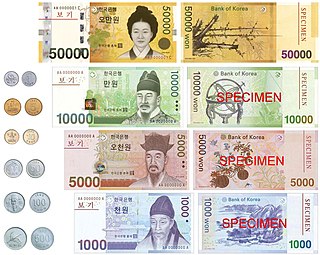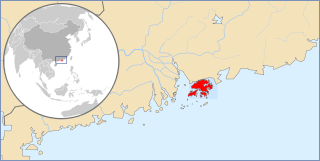
The renminbi is the official currency of the People's Republic of China. It is the 5th most traded currency as of April 2022.

The Mexican peso is the currency of Mexico. Modern peso and dollar currencies have a common origin in the 16th–19th century Spanish dollar, most continuing to use its sign, "$".
The Korean People's won, sometimes known as the North Korean won or Democratic People's Republic of Korea won, is the official currency of North Korea. It is subdivided into 100 chon. The currency is issued by the Central Bank of the Democratic People's Republic of Korea, based in the North Korean capital city of Pyongyang.

The South Korean won is the official currency of South Korea. A single won is divided into 100 jeon, the monetary subunit. The jeon is no longer used for everyday transactions, and it appears only in foreign exchange rates. The currency is issued by the Bank of Korea, based in the capital city of Seoul.
The New Taiwan dollar is the official currency of the Republic of China (Taiwan). The New Taiwan dollar has been the currency of the island of Taiwan since 1949, when it replaced the Old Taiwan dollar, at a rate of 40,000 old dollars per one new dollar. The basic unit of the New Taiwan dollar is called a yuan (圓) and is subdivided into ten chiao (角), and into 100 fen (分) or cents, although in practice both chiao and fen are never actually used.

Banknotes of the Philippine peso are issued by the Bangko Sentral ng Pilipinas for circulation in the Philippines. The smallest amount of legal tender in wide circulation is ₱20 and the largest is ₱1000. The front side of each banknote features prominent people along with buildings, and events in the country's history while the reverse side depicts landmarks and animals.

The kip is the currency of Laos since 1955. Historically, one kip was divided into 100 att (ອັດ).
Peso dominicano has been the name of the currency of the Dominican Republic since 2011. Its symbol is "$", with "RD$" used when distinction from other pesos is required; its ISO 4217 code is "DOP". Each peso is divided into 100 centavos ("cents"), for which the ¢ symbol is used. With exception of the United States dollar, it is the only currency that is legal tender in the Dominican Republic for all monetary transactions, whether public or private.

The Taiwanese yen was the currency of Japanese Taiwan from 1895 to 1946. It was on a par with and circulated alongside the Japanese yen. The yen was subdivided into 100 sen (錢). It was replaced by the Old Taiwan dollar in 1946, which in turn was replaced by the New Taiwan dollar in 1949.

The issue of banknotes of the Hong Kong dollar is governed in the Special Administrative Region of Hong Kong by the Hong Kong Monetary Authority (HKMA), the governmental currency board of Hong Kong. Under licence from the HKMA, three commercial banks issue their own banknotes for general circulation in the region. Notes are also issued by the HKMA itself.

The history of Chinese currency spans more than 3000 years. Currency of some type has been used in China since the Neolithic age which can be traced back to between 3000 and 4500 years ago. Cowry shells are believed to have been the earliest form of currency used in Central China, and were used during the Neolithic period.
The yuan is the base unit of a number of former and present-day currencies in Chinese.
The fourth series of the renminbi was introduced between 1987 and 1997 by the People's Bank of China. The theme of this series was that under the governance of the Chinese Communist Party, the various peoples of China would be united in building a Chinese-style social democracy.
The fifth series of the renminbi is the current coin and banknote series of the Chinese currency, the renminbi. They were progressively introduced since 1999 and consist of ¥0.1, ¥0.5, and ¥1 coins, and ¥1, ¥5, ¥10, ¥20, ¥50, ¥100 notes. The ¥20 banknote is a new denomination, and was added in this series. All banknotes in this series feature a portrait of Chinese Communist Party chairman Mao Zedong by artist Liu Wenxi.
The fifth series of the new Taiwan dollar banknotes is the current and latest series to be issued for circulation in the Republic of China (Taiwan). It was first introduced by the Central Bank of the Republic of China (Taiwan) on 3 July 2000.
The history of Philippine money covers currency in use before the Hispanic era with gold Piloncitos and other commodities in circulation, as well as the adoption of the peso during the Hispanic era and afterwards.

The paper money of the Qing dynasty was periodically used alongside a bimetallic coinage system of copper-alloy cash coins and silver sycees; paper money was used during different periods of Chinese history under the Qing dynasty, having acquired experiences from the prior Song, Jin, Yuan, and Ming dynasties which adopted paper money but where uncontrolled printing led to hyperinflation. During the youngest days of the Qing dynasty paper money was used but this was quickly abolished as the government sought not to repeat history for a fourth time; however, under the reign of the Xianfeng Emperor, due to several large wars and rebellions, the Qing government was forced to issue paper money again.

The Ta-Ching Government Bank, known as the Ta-Ching Bank of the Ministry of Revenue (大清戶部銀行) from 1905 to 1908, was the name of the Bank of China as a government agency of the Qing dynasty until the empire's dissolution in 1912. It was originally created to serve as the central bank of China in 1905, originally as a division of the Ministry of Revenue, and would serve as the country's de facto central bank until the establishment of the Central Bank of China in 1924.

The banknotes of the Ta-Ching Government Bank, known as the banknotes of the Ta-Ching Bank of the Ministry of Revenue from 1905 to 1908, were intended to become the main form of paper money in the Qing currency system. These banknotes were issued by the Ta-Ching Government Bank, a national bank established to serve as the central bank of the Qing dynasty. The Ta-Ching Government Bank had branches throughout China and many of its branches outside of its headquarters in Beijing also issued banknotes.

Qiang tie is a Chinese folk name for banknotes of the Russian ruble issued by the Russian Empire and later by the White Army. The main regions of ruble transactions in China were concentrated along the Chinese Eastern Railway and Harbin in Manchuria and Ili and Tacheng in Xinjiang. Russian currency in China began circulating in the 1860s and were withdrawn due to severe depreciation in the mid-1920s. There were many qiang tie sources, including the State Bank of the Russian Empire, the Russian Provisional Government, Omsk bonds issued by the Provisional All-Russian Government, the Russo-Chinese Bank, and the administration of the Eastern Railway.







































































































































